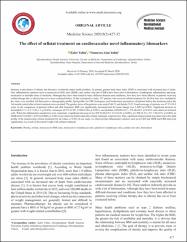| dc.description.abstract | Increase in prevalence of obesity has become a worldwide major health problem. In general, greater body mass index (BMI) is associated with increased rate of death. New inflammatory markers (such as monocyte-to-HDL ratio (MHR), and cardiac risk ratio (CRR)) have been used as biomarkers of pathogenic inflammation and prognostication in multiple areas of medicine. Although they have been tested in many different diseases and conditions, how they have been affected in patients receiving orlistat therapy due to obesity has never been evaluated before. In this retrospective study, 197 patients who received orlistat treatment for the first time were included in the study were enrolled. All data (such as demographic profile, lipid profile, hs-CRP, hemogram, and biochemical parameters) of patients before the treatment and at the 3rd-month control after orlistat treatment were recorded. The gender ratios of the patients were male (%46.7) and female (%53.3) and mean age of patients was 47.13±10.9 years. In the comparison of patients before and after treatment, BMI was significantly decreased and the mean change was 3.4054 (p<0.001). Significant decrease in neutrophil (5.71±1.9, 5.39±1.5, p=0.016), monocyte (0.572±0.207, 0.508±0.164, p<0.001), and platelets (309.09±102.1, 276.08±60.2, p=0.023) were observed in blood cells. When the inflammatory parameters were examined, a significant decrease in hs-CRP (0.88±0.52, 0.67±0.28, p<0.001), in CRR (4.32±1.07, 3.94±0.92, p<0.001), in MHR (0.0135±0.0057, 0.0116±0.0049, p<0.001) were observed (before and after orlistat treatment, respectively). Also, significant improvement was observed in the lipid profile of the patients after orlistat treatment (for all values, p<0.05). In our study, we observed that inflammatory markers such as hs-CRP and MHR and CRR improved significantly as a result of decreased weight with orlistat treatment. | en_US |
















